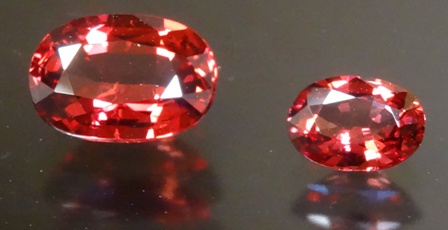Ruby gets the lion’s share of attention when it comes to red gems. But there is one red gemstone that has made a career out of being mistaken for ruby. The finest specimens can stand up to just about any ruby that’s ever been mined in color and clarity. It’s actually considerably rarer than ruby of comparable quality, too, but due to its combination of scarcity and historical lack of credit, this is one of the great bargains of the gemstone world. I’m talking about spinel.
Most people you ask about spinel will say something like, “Oh, isn’t that the fake stone they put in class rings?” While that may be a warranted response, it’s not entirely accurate. Spinel is an exquisite naturally occurring mineral that has been the victim of false advertising for centuries.

2.87 carat oval red spinel and 0.98 carat oval red spinel
Consider the Crown Jewels of The United Kingdom. The Black Prince’s Ruby? Red spinel. The Timur Ruby? Red spinel. The Black Prince’s Ruby has been in possession of the Royal Family since 1367, but it wasn’t identified as spinel until the 1940s.
The confusion through time is easy to understand. Spinel has a similar density to corundum, an almost identical color palate, and very, very similar optical properties, especially to unaided human perception. Fine red spinel and ruby from the ancient sources in Central Asia and Eastern Asia also literally glow red in sunlight, a trait that other historically popular red gems such as garnet, zircon, and carnelian do not possess.
But all that doesn’t mean ancient lapidaries were incapable of basic observation. The major physically noticeable difference between ruby and spinel is hardness. The actual hardness of spinel is only one-half that of corundum. Despite both being colored a vibrant flame red, a gemcutter in 3rd Century B.C. India would’ve noticed a difference between fashioning ruby and fashioning spinel.
Even though spinel is significantly softer than corundum, only diamond, corundum, and chrysoberyl (alexandrite) are the only mainstream jewelry gems that are harder than spinel. A small handful of other extremely obscure minerals are also harder than spinel, but most people will never hear the names of, let alone see any of them in a jewelry store. Spinel really is one of the hardest natural materials in the world. Other popular gems of Antiquity, such as emerald, peridot, lapis lazuli, topaz, and zircon are easily outclassed by spinel’s durability. That fact allowed spinel to retain a high regard amongst lapidaries over the centuries, whether or not they knew what they were actually working with.
Further complicating matters is the fact that spinel and corundum often occur in tandem. Consider the major ruby and sapphire mines of yore: Mogok in Burma; the Sri Lankan gem gravels; the legendary mines of Badakhshan in what is now Tajikistan. All of those were or are now known to produce spinel right alongside ruby. Spinel has even been found accidentally in parcel with sapphires from Montana.
As I’ve said, spinel really is the bargain of the colored gem world. Its robust physical properties, stability, and its broad color palate serve to make it an excellent stone for any and all types of jewelry. Its hardness and lack of cleavage make it perfect for rings and bracelets.
When shopping for spinel, your pickings may be slim outside of an independent jewelry store specializing in color. That’s part of the reason why it’s so affordable compared to gems like ruby and sapphire: there’s no demand pressing the supply.
Size is a main restrictor. Spinels over 5 carats are very uncommon, and you’ll likely not see many faceted stones over 3 carats. While a 3-carat spinel is an impressive size, if you’re looking for something larger than that, you’ll need to give me time to track it down. Those stones are out there, but it will take some hunting.

3.08 carat round blue spinel and 0.81 carat oval blue spinel
While spinel and corundum share much the same color palate, there are some primary differences you may notice outside of the absolute top-tier stones. Reds may tend to have an orangey undertone, and typical blues tend to be overly dark or steely. Spinel does pastel purple, violet, and mauve very nicely, though. Spinel can also be one of the most intensely pink facetable gemstones in the world. Silvery gray spinel is a fun novelty you might stumble across, too. Natural yellow and green spinel is rare: as in mostly-only-found-in-museums-rare. The same goes for natural colorless spinel, which was only discovered within the last decade, at most. Spinel also comes in opaque black, which is more durable than black onyx, and although not as durable as black diamond, is more affordable.
Spinel also occurs in phenomenal forms. Color-change spinel is cool stuff. I only have one of those in stock right now, but I can certainly find you more. Star spinel also exists. It may either be four-rayed or six-rayed, depending on the orientation of the needles to the growth of the spinel crystal.
Spinel is also a gemstone that is rarely, if ever, treated. Heating and irradiation don’t usually have any effect on spinel. The only thing you’re likely to run into is synthetic material, but the price and perfection of these stones will be dead giveaways.
If you’re interested in seeing this remarkable gemstone for yourself, I have a small collection of loose spinels on hand. If nothing else, you can tell your friends about how beautiful spinel is, and that, no, it is not just a cheap synthetic.
Check out this article from GIA on spinel in Mogok, Burma – the source of the finest rubies in the world:
http://www.gia.edu/gems-gemology/spring-2014-pardieu-jedi-spinels-in-mogok
Tags: black diamond, blue spinel, gemstones, jewelry, lapis lazuli, red spinel, ruby, spinel, zircon